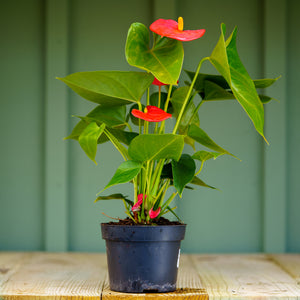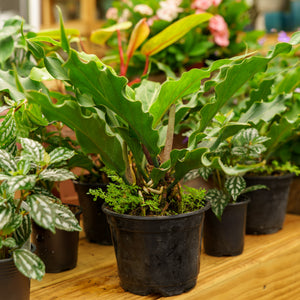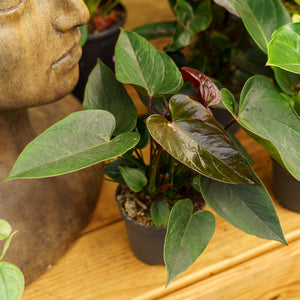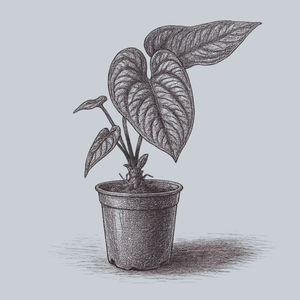The Anthurium Guide
Anthurium, commonly known as Flamingo Flower or Laceleaf, is a striking tropical plant prized for its glossy, heart-shaped leaves and long-lasting, vibrant blooms. With over 1,000 species, Anthuriums offer a diverse range of foliage and flower forms, making them a favorite among houseplant enthusiasts and tropical gardeners. Whether grown for their colorful spathes or their uniquely textured foliage, these plants add elegance and tropical appeal to any indoor or outdoor space. Here’s everything you need to know about growing and caring for Anthurium.
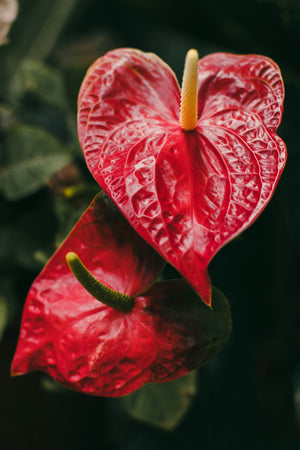
About
Anthurium belongs to the Araceae family and originates from the rainforests of Central and South America. These epiphytic or terrestrial plants thrive in warm, humid environments, where they naturally grow on tree trunks or in loose, organic-rich soil.
Anthurium varieties range from the classic, brightly colored flowering types, such as Anthurium 'Orange' and Anthurium 'Zizou', to stunning foliage varieties like Anthurium 'Black Beauty', known for its dark, velvety leaves, and Anthurium 'Magnificum', which features large, dramatic leaves with striking venation. Another unique species, Anthurium hookeri (Bird’s Nest Anthurium), is admired for its rosette-forming habit and deeply textured foliage.
Flowering Anthuriums produce long-lasting, waxy spathes surrounding a central spadix, available in shades of red, pink, orange, and even green. These blooms are popular in floral arrangements due to their durability. Foliage Anthuriums, on the other hand, are cultivated for their intricate leaf shapes, textures, and veining patterns.
With proper care, Anthuriums thrive indoors as houseplants or outdoors in warm, humid climates, bringing a lush, exotic touch to any setting.

PLANTING
- USDA Hardiness Zones: Best suited for Zones 10-12 when grown outdoors; can be grown indoors in any climate.
- Soil: Prefers a well-draining, loose, and organic-rich mix. A combination of orchid bark, perlite, and peat moss works well.
- Sunlight: Requires bright, indirect light. Avoid direct sun, which can scorch leaves, but also avoid deep shade, which can reduce flowering.
- Watering: Water when the top inch of soil feels dry. Keep soil consistently moist but never waterlogged.
- Humidity: Thrives in high humidity (above 60%). Consider using a pebble tray, humidifier, or occasional misting to maintain moisture levels.
- Spacing: Allow ample air circulation between plants to prevent fungal issues.
- Planting Time: Can be planted or repotted any time of year, though spring is ideal for encouraging new growth.
When potting Anthuriums, use a container with drainage holes and ensure the roots are nestled in the soil but not deeply buried. Gently firm the soil around the base and water lightly.
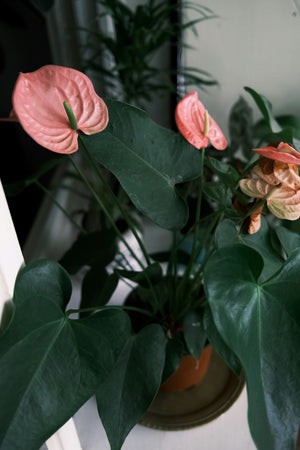
CARE
- Watering: Maintain consistent moisture but avoid overwatering, as Anthuriums are prone to root rot.
- Fertilizing: Feed with a diluted balanced liquid fertilizer every 6-8 weeks during the growing season (spring and summer).
- Pruning: Trim dead or yellowing leaves to encourage healthy new growth. Cut spent flowers to promote reblooming.
- Repotting: Repot every 2-3 years or when the plant outgrows its container, refreshing the potting mix for optimal health.
- Pests & Diseases: Watch for spider mites, aphids, and mealybugs. Treat infestations with neem oil or insecticidal soap.
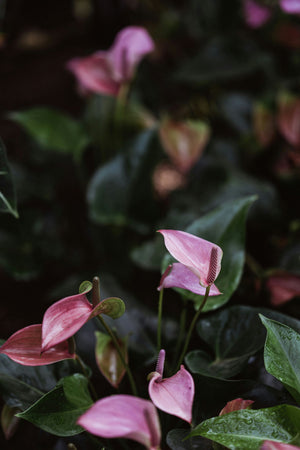
HOW TO USE
Anthurium’s striking foliage and colorful blooms make it a standout in many settings:
- Houseplants: Perfect for brightening up indoor spaces with their glossy leaves and vibrant flowers.
- Tropical Gardens: Adds exotic appeal when grown in shaded outdoor beds in warm climates.
- Container Gardening: Thrives in decorative pots on patios or in greenhouse environments.
- Floral Arrangements: Cut flowers last for weeks, making Anthurium a favorite for bouquets and centerpieces.
- Air Purification: Helps improve indoor air quality by filtering toxins from the air.
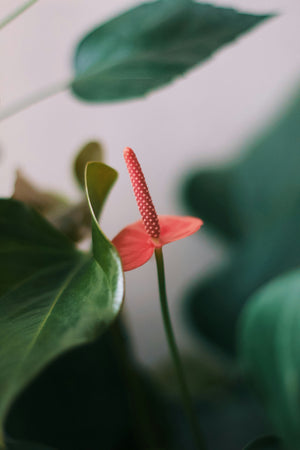
Common Questions
- How to care for Anthurium plants? Provide bright, indirect light, maintain high humidity, water when the top inch of soil is dry, and fertilize during the growing season.
- Is Anthurium toxic to cats? Yes, Anthurium is toxic to cats. It contains calcium oxalate crystals that can cause mouth irritation and digestive discomfort if ingested.
- Is Anthurium toxic to dogs? Yes, Anthurium is toxic to dogs and can cause similar symptoms, including mouth irritation and vomiting.
- How to propagate Anthurium? Anthurium can be propagated by dividing offsets from the main plant or by stem cuttings placed in water or moist soil.
Conclusion
Anthurium is an elegant, easy-to-care-for tropical plant that brings vibrant color and texture to indoor and outdoor spaces. Whether you prefer the classic flowering varieties or the bold foliage types, these plants add a sophisticated touch to any collection. With selections like Anthurium 'Magnificum', Anthurium 'Black Beauty', and Anthurium 'Radicans x Luxurians', there is an Anthurium variety suited for every plant enthusiast. Explore our collection and enjoy the beauty of Anthurium in your home or garden.
The Anthurium Collection
Sold Out
Sold Out
Sold Out
Sold Out

